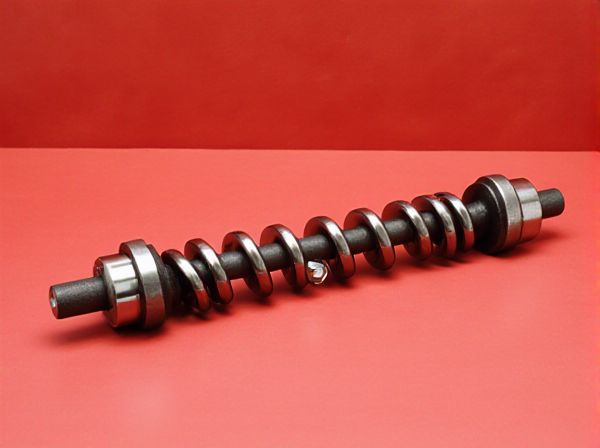
Photo illustration: One-Piece Crankshaft vs Two-Piece Crankshaft
A one-piece crankshaft offers superior strength and durability by integrating the entire shaft into a single forged or cast unit, which reduces the risk of misalignment and improves engine reliability. Two-piece crankshafts, often easier to manufacture and repair, consist of two separate halves bolted or welded together, providing cost advantages but potentially sacrificing some strength and precision. Your engine's performance and maintenance preferences will determine the ideal choice between the robust one-piece design and the more service-friendly two-piece crankshaft.
Table of Comparison
| Feature | One-Piece Crankshaft | Two-Piece Crankshaft |
|---|---|---|
| Construction | Single solid forged or cast piece | Two segments joined by a flange or bolts |
| Strength | Higher structural integrity, less stress points | Lower strength due to join, potential weak spots |
| Manufacturing Cost | More expensive due to forging and machining | Less costly, simpler assembly |
| Maintenance | Requires replacement of entire crankshaft if damaged | Possible to replace or repair individual sections |
| Installation | Challenging due to size and weight | Easier assembly and transport |
| Applications | Performance and heavy-duty engines | Commercial and older vehicle designs |
| Durability | Longer lifespan with less risk of failure | Potential for joint wear and fatigue over time |
Overview of Crankshaft Designs
One-piece crankshafts are manufactured from a single solid piece of metal, offering superior strength and durability ideal for high-performance engines. Two-piece crankshafts consist of two separate components joined together, allowing easier repairs and manufacturing flexibility but potentially sacrificing some rigidity. The choice between these designs depends on engine application, balancing factors such as strength, maintenance, and cost.
What is a One-Piece Crankshaft?
A one-piece crankshaft is a solid, single forged or cast component forming the entire crankshaft, offering superior strength and durability compared to multi-piece designs. It reduces the risk of misalignment and potential failure since all sections are integrated, enhancing engine performance and reliability under high stress. Commonly used in high-performance and heavy-duty engines, one-piece crankshafts provide consistent rotational balance and longevity in demanding applications.
What is a Two-Piece Crankshaft?
A two-piece crankshaft consists of two separate components joined together, typically by a flange and bolts, allowing easier manufacturing and repair compared to a one-piece design. This design enhances flexibility in assembly and maintenance, especially in large engines where handling a single piece crankshaft is challenging. Two-piece crankshafts also facilitate improved balancing and stress distribution, contributing to engine reliability and performance under heavy-duty conditions.
Manufacturing Processes Compared
One-piece crankshafts are manufactured through a forging process that results in a single, solid component, offering higher strength and durability due to uniform grain flow and minimal joints. Two-piece crankshafts involve assembling two separately forged or cast halves, which can simplify manufacturing and reduce costs but introduce potential weak points at the joint requiring precise machining and alignment. The choice between these processes impacts production time, material usage, and mechanical reliability in automotive engine applications.
Material Strength and Durability
One-piece crankshafts are typically forged from a single solid billet of high-strength steel, providing superior material strength and enhanced durability by minimizing weak points. Two-piece crankshafts, often constructed by welding or assembling separate sections, may exhibit reduced overall strength due to potential stress concentrations at joints, impacting long-term durability. Forged one-piece designs are preferred in high-performance engines for their increased resistance to bending and torsional stresses, ensuring reliable operation under demanding conditions.
Performance Differences
One-piece crankshafts offer superior rigidity and reduced flex under high torque conditions, enhancing engine performance and reliability. Two-piece crankshafts provide easier manufacturing and maintenance but may introduce slight flex and vibration, potentially impacting high-RPM efficiency. Performance-oriented engines favor one-piece designs for improved power delivery and durability.
Cost Analysis and Affordability
One-piece crankshafts generally offer lower initial costs due to simpler manufacturing processes and reduced assembly requirements, making them more affordable for budget-conscious projects. Two-piece crankshafts, while typically more expensive upfront because of complex machining and tighter tolerances, provide enhanced durability and easier repair options, potentially lowering long-term maintenance expenses. Evaluating overall affordability requires balancing the upfront cost savings of one-piece designs against the extended service life and reduced overhaul costs characteristic of two-piece crankshafts.
Applications in Automotive Engineering
One-piece crankshafts are commonly used in high-performance engines where maximum rigidity and durability are required, such as in racing cars and heavy-duty commercial vehicles. Two-piece crankshafts offer advantages in complex engine assemblies, facilitating easier manufacturing, assembly, and repair in passenger cars and light trucks. Automotive engineers select one-piece crankshafts for applications demanding superior strength and balanced rotational dynamics, while two-piece crankshafts are preferred for modular designs and cost-effective maintenance.
Maintenance and Repair Considerations
One-piece crankshafts offer simpler maintenance due to fewer joints, reducing the likelihood of misalignment and easing inspection for wear or damage. Two-piece crankshafts, while more complex, allow for easier replacement of damaged sections without removing the entire assembly, which can be cost-effective for large engines. Repair considerations favor one-piece designs for durability, whereas two-piece crankshafts provide modularity that can minimize downtime during part-specific repairs.
Which Crankshaft is Right for Your Engine?
One-piece crankshafts offer greater rigidity and reliability for high-performance engines, reducing vibrations and enhancing power delivery. Two-piece crankshafts provide easier installation and repair options, making them suitable for engines requiring frequent maintenance or modifications. Selecting the right crankshaft depends on engine application, performance needs, and maintenance preferences.
 caratoz.com
caratoz.com